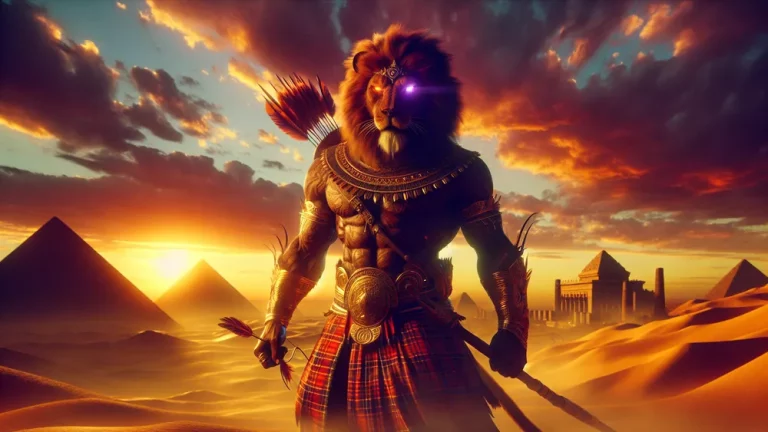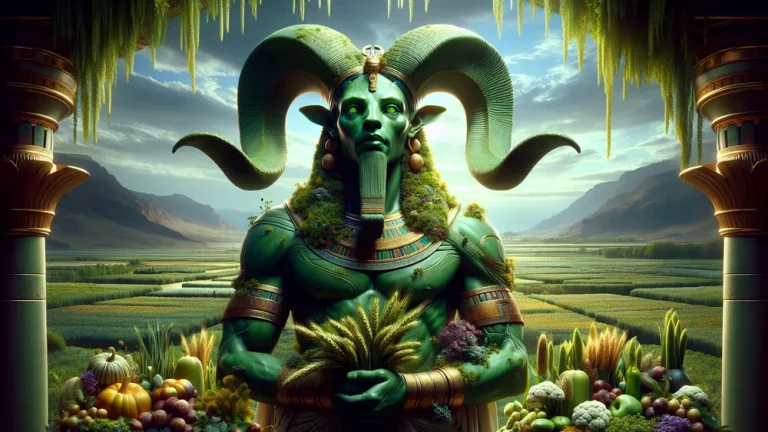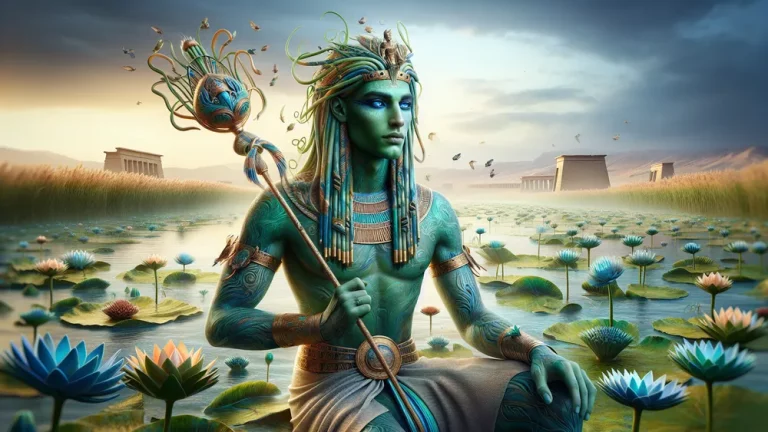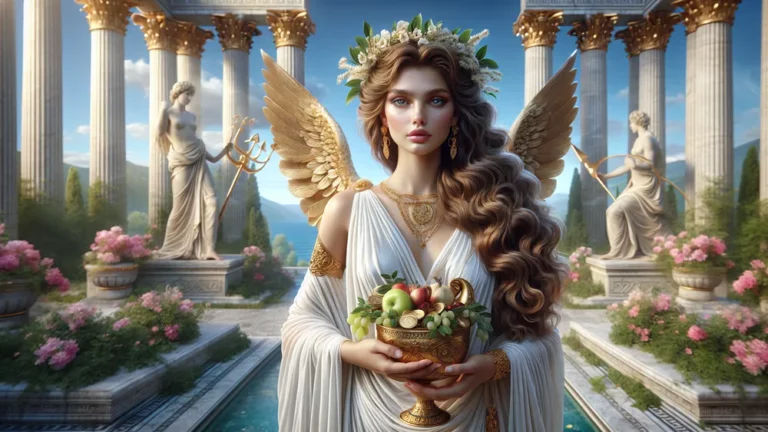Kalokagathia: Ancient Greek Ideal Of Beauty And Goodness
Kalokagathia, made from “kalos” meaning beautiful and “agathos” meaning good, stands for an old Greek ideal that wanted a good mix of looking nice and being a good person. Really big in Greek ways, it got into stuff like learning and even their gods.
Key Points:
- Kalokagathia combines looking good (kalos) and being good (agathos), an old Greek idea.
- Greek thinkers like Socrates and Plato pushed Kalokagathia’s importance in both looks and morals.
- Greek culture embraced Kalokagathia through education, sports, and civic life.
- Heroes and gods in myths like Heracles and Athena mix outer beauty and inner goodness.
- Education in Greece aimed for balanced growth of body and mind, reflecting Kalokagathia.
- Social status and citizenship were linked to having Kalokagathia, both beautiful and good.
- Stories and myths warned against loving only looks, pushing the balance of virtue and beauty.
Think about now, ideals where looks are not just about what you see; but, instead, they’re mixed up with good things like being honest and fair. It shows how the people wanted folks who don’t just look good but have high moral values too.
When you start to get what Kalokagathia is about, it’s really important to know how it was part of what Greeks thought, mixing how you looked with being a good person.
We are going to talk about how it all started, how it got into Greek life, and how it seemed in myths, while knowing that different times and chats might mean Kalokagathia in different ways.
Kalokagathia: Overview and Key Facts
| Aspect | Description |
|---|---|
| What it means | Kalokagathia is a Greek word that mixes “kalos” for beautiful and “agathos” for good, meaning an idea about looks and being a good person. |
| Where it came from | Born from old Greek thinking, around the 5th century BCE, Kalokagathia came out with big thinkers like Socrates, Plato, and Aristotle talking about it. |
| Why it mattered | Main in Greek ways, it pushed both how things looked and ethics, and it was really big in learning and how people acted, making folks aim for physical and being a good person too. |
| Who liked it | There were important thinkers from Greece who liked how mind and body could grow equally, so they mixed in brave acts, being honest, and looking good into who someone is. |
| In myths | Seen in Greek myths through gods like Aphrodite and Athena, where how things appear and being wise were seen together, showing Kalokagathia in big stories. |
| How it affected people | An important piece of social class and who got to be in public life, this idea pushed folks to get better inside and out, meaning personal deeds were important for being part of groups and getting people to grow as citizens. |
| Living on | Even though it started in old books, Kalokagathia’s ideas have been looked at many times in different chats over a long time, making today’s thoughts on being good and what looks nice. |
Roots in History of Kalokagathia
If you want to understand the idea of Kalokagathia, it’s important to look into its historical roots and think about what ancient Greeks and their thinkers did. Because they took on and spread this idea.
Ancient Greek Beginnings
Kalokagathia started in old Greece, a place where thinking and daily life were connected. Socrates and other thinkers were a big part of spreading this idea, seeing the mix of how someone looks outside and their goodness inside as important to living a life that feels balanced.
Think of it like modern efforts for being both smart and kind, wanting an outside that matches good insides – a complete way not new now, but from these old starts. While mostly looked at in talks about ways to think, Kalokagathia wasn’t just an idea; it was something people tried to do in learning, sports, and how they lived.
These early ideas grew strong in a society that liked brave acts and smart thinking the same, making Kalokagathia a big part of how they saw the “good life.” Even if views change, and books say different things, the acknowledgment of these great thinkers and what they gave helps us understand how Kalokagathia got into Greek ways.
Kalokagathia in ancient Greece was an important concept combining outward appearance with inner goodness, deeply influencing their society’s views on a balanced and fulfilled life through learning, sports, and ideals.
How Greek Life Embraced It
In ancient Greek times, Kalokagathia wasn’t just some difficult thinking; it was something that spread through everyday life, a way for people to see their own worth. Education became one main place where this idea was made strong. Greeks wanted a very complete learning system called “paideia,” aiming to grow both body and mind – kind of like the idea of a healthy mind and body.

Classes in thinking, music, and exercise were put together in a course meant to create citizens who meant Kalokagathia’s main ideas. Embodying the ideas of beauty was expected in life, so people had to keep these high standards in private and public tasks, and they built a place that really liked personal success as a group value.
Putting Kalokagathia ideas into action reached beyond learning and went into many parts of Greek culture, such as sports and events. For example, being fit wasn’t just about looking good or being healthy but a way to see someone’s smartness and moral strength. The Olympic Games, and other sports, supported these ideas, where those involved looked not only fit but fair and honest, too. Greek plays and statues said this by showing people who meant both good looks and moral good. This way, Greeks didn’t only think about Kalokagathia, but they also made rules and culture to grow these values completely. Important parts that pushed these values include:
- Education: Growing both mind and body mattered in how people learned.
- Athletics: Sports put emphasis on being fit and doing right.
- Art and Sculpture: Looks in art meant higher moral ideas.
- Public Ceremonies: Civic events praised the mix of traits in Kalokagathia.
These parts made Kalokagathia a main part of Greek ways, saying how crucial it was as an idea for guidance.
Legendary Stories
In Greek stories, the meeting of beauty and goodness is clearly shown through interesting stories of gods and heroes, telling what Kalokagathia is about. Aphrodite and Athena, these gods, are key examples of this idea. They have different areas, like love and wisdom. Aphrodite, who is about love and looks, stands for appearance; Athena, who is about wisdom and war, means smart and plans well.
They often play parts that mean looks together with virtue – a duality like a hero now having charm and being really good inside. This mix is often noted in heroes like Perseus and Hercules, where their strength and nobility are said. It is important to say different regions or writers sometimes told these myths differently, which says how Kalokagathia could be seen or focused on in many ways.
Such stories worked as important parts that put these respected values of Kalokagathia deeply into how Greeks thought.
Philosophical Aspects of Kalokagathia
To clearly understand the full meaning of Kalokagathia, looking into its philosophical foundations is needed, as said by the wise Greeks of old times.
Philosophers’ Views
In ancient Greece, thinkers like Socrates, Plato, and Aristotle brought the basic ideas for Kalokagathia, because each had unique perspectives on what it means. Socrates, through his talks, often brought virtue into focus, talking about how knowledge and goodness are linked inside, saying wisdom naturally means being good. While Plato, a student of Socrates, threw this idea into his theory of Forms.
He said true beauty and goodness are perfect and forever, only understood through thinking deeply, like going from a first liking to deep knowing. Aristotle, once a student of Plato, looked at Kalokagathia differently. He said beauty and goodness were not just ideas to think about but things to show through habits and actions that make life balanced – an idea in his “Golden Mean.”
These thinkers’ combined efforts made many viewpoints on Kalokagathia, exploring how inside traits and outside looks mix to form an ideal way of being. To see their views clearly, consider the table below, which points out the differences in how they thought:
| Philosopher | Key Concept | View on Kalokagathia |
|---|---|---|
| Socrates | Knowledge-Virtue Connection | Wisdom and learning mean being good inside. |
| Plato | Theory of Forms | True beauty and goodness are ideal things understood through thinking. |
| Aristotle | Golden Mean | The balance of actions and character is the height of beauty and good. |
These ideas ask us to see not only how complex old thought was but also the ongoing search for being excellent in mind and body.
Moral Meanings
Kalokagathia in Greek thought means that beauty and goodness deeply mix, focusing on how working together on character leads to being ethically excellent. The Greek thinkers thought beauty without goodness was surface-level, saying real goodness included living a balanced life that means having honesty, fairness, and control.

Like when Aristotle talks about the “Golden Mean,” it means being moderate and balanced is key in living right. Along the same lines, nowadays, we think about balance, like how too much work without rest can be bad for us. The idea behind Kalokagathia tells us moral goodness needs a full self, where inside looks as good as the outside.
While agreeing on harmony, Greek thinkers saw different ways this idea could happen in life, and that says a lot about the many ideas in old Greek thought.
Kalokagathia in Mythology
Now that we’ve looked at the philosophical sides of Kalokagathia, we can see how this idea was part of mythology, and it means through interesting stories and characters, its effect can be seen clearly.
The Tale of Heracles and His Triple Goodness
Heracles is a strong example of the Greek idea Kalokagathia, where he is a mix of looks, bravery, and doing the right thing. Known to the Romans as Hercules, he appears as the model of a strong man and goodness – a half-god, going through tasks more than what humans do usually.
Imagine the Twelve Labors, tasks that King Eurystheus gave to him, meaning his great strength and a test of his character in taking and winning against huge problems. Each job means something of his goodness: strength when beating the Nemean Lion, smart thinking when cleaning the Augean stables, and courage capturing Cerberus from the Underworld.
But, in many tales, there are changes in how these actions focus on different parts of who he was, saying a lot about the spoken stories through history. His journey isn’t just about physical wins; it’s about fully seeing what being good is, far beyond just being strong.
The story says he was extremely good-looking, shown in art as the classic hero with divine features. But he wasn’t free from faults. He had battles inside that needed much thought and change, like managing his wild anger and doing jobs that didn’t always match what he wanted.
This complexity makes him someone you can relate to, facing life’s many problems, similar to today’s efforts for self-improvement where being balanced in virtues is key for overall growth.
To make it easier to see how Heracles showed Kalokagathia, think about these main parts of who he was:
- Physical Beauty: His god-like power and looks.
- Bravery: Seen through courage in dangerous jobs.
- Moral Integrity: Proved by sticking to his duties and working hard.
By engaging with Heracles’ story, you see how old stories try to mean the need to mix outside charm with inner goodness; this message stays relevant today in how we understand whole personal development.
Heracles, or Hercules, serves as a prime Greek example of blending physical appeal, bravery, and moral duty, best illustrated through his Twelve Labors which test his strength, intelligence, courage, and ethical values, while also highlighting the complexities of his character and ongoing struggle for self-growth.
The Story of Narcissus
The story of Narcissus, from Greek myths, is a clear example, telling us about the risks of being too focused on oneself and not understanding Kalokagathia. The tale says Narcissus was an exceptionally beautiful young man who got obsessed with his image in the water, and this obsession led to his end.

This myth highlights the danger of mixing up physical looks with true goodness. It warns us that focusing too much on ourselves can make us miss out on real bonds with others and the world, a message that fits well with today’s social media vanity problems.
In some versions, the story of Narcissus’ focus not only tells of his fall but also means the blindness from his arrogance, like when he doesn’t see the love and human sides of those near him, especially Echo, the nymph.
This tale counters Kalokagathia, showing that the best qualities often mean finding balance and seeing selflessness as truly meaningful – an idea that fits across different cultures and times.
Kalokagathia’s Impact on Greek Life
As we now understand more about how Kalokagathia was in Greek myths, it’s time to look at its real effects on different parts of Greek life, which formed ideas about both how people grew individually and community values. This mattered.
Learning and Games
The ideas of Kalokagathia, in ancient Greek society, weren’t just thoughts but real-life principles placed in their education and sports systems. Aiming to make a person better was the goal of education in classical Greece, pushing for individuals to be both fit and morally good. In particular, schools in Athens had this dual focus, mixing physical workouts with moral and intellectual lessons.

So, at the gymnasium, kids took part in physical exercises and joined in on talks to improve both body and mind at the same time. Think about how this compares to today’s educational systems, which stress having a broad range of subjects like science, arts, and sports, meaning a varied approach to personal growth. It was balanced.
And then there were the Olympic Games. The impact of Kalokagathia was clearly seen in these events, which started in 776 BCE for Zeus. More than just sports, they meant praise for human talent, presenting abilities that matched god-like features by building up both physical and moral parts in people taking part.
Events such as the pentathlon and wrestling pushed competitors to display their strength and stamina while keeping fairness and control, which were important ideas in Greek thinking.
So, by joining in the Olympic spirit, athletes reflected the Greek belief that being truly noble comes from balancing body and soul – a belief still present in our world today as we respect the complete harmony of mental and physical gains in sportsmanship and learning equally.
Social Status and Citizenship
Kalokagathia was an essential part of forming social and citizen ideals in ancient Greece. This was an example of what being virtuous meant and what it was to be respected in Greek life. It required a person to have both physical looks and moral excellence, forming the base for someone to be an active, contributing part of the city-state, or polis.
Similar to how today’s leaders are expected to mean honesty and responsibility as well as being relatable, in ancient times, it was about finding a noble mix between personal and public lives. In places like Athens and Sparta, focusing on Kalokagathia meant young people learned not just for themselves but to get ready for roles that would strengthen the state. They were trained for jobs like being in local meetings or the army.
Having Kalokagathia was about reaching the highest civic duty standards and showed that a person’s goodness and the community’s well-being were closely tied.

Pantheon of Greek Mythology’s Spirits and Daimones
In the varied stories of Greek mythology, spirits and daimones were very important as go-betweens for gods and humans. They often represented parts of nature, feelings, or parts of human life. These beings, differing in how important they were, ranged from friendly helpers called ‘agathodaemon‘ to bad spirits that made trouble or brought harm.
Unlike the main gods on Olympus, spirits and daimones helped people make sense of things they couldn’t see or touch, kind of like spirits today in different myths around the world. They had complex roles that mattered to beliefs of the time because they were respected, feared, or called upon in everyday life and religious acts.
For anyone interested in learning more about each one and how they fitted into Greek myths, a very detailed list of all the greek Spirits and Daimones can mean new interesting findings.
FAQs
1. What are the core virtues of Kalokagathia in Greek philosophy?
The core virtues of Kalokagathia in Greek philosophy encompass an ideal blend of physical beauty, moral goodness, and intellectual excellence.
2. How did ancient Greek society implement Kalokagathia?
Ancient Greek society implemented Kalokagathia by integrating the principles of physical beauty, moral excellence, and intellectual education into their educational systems and civic life.
3. Which ancient myths best represent Kalokagathia’s ideals?
Ancient myths best representing Kalokagathia’s ideals include those of Heracles and Athena, which emphasize the balance of physical beauty, courage, and moral virtue.
Kalokagathia compares to similar concepts in other cultures by embodying the harmonious blend of beauty and virtue, akin to the Confucian ideal of the junzi in China and the Renaissance ideal of the uomo universale in Europe.







